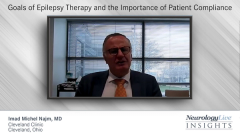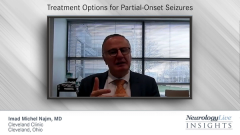
Treatment Options for Partial-Onset Seizures
An overview of available treatment options in epilepsy treatment to increase patient compliance, and a deeper diver into the recent data from the phase 4 ELEVATE study of perampanel.
Imad Michel Najm, MD: We use the same strategy to treat partial-onset seizures that we do with generalized convulsive seizures. Even though some patients say, “Doctor, I have very small seizures. I just basically blank out for 20 or 30 seconds. I have some mild tremors in my hand,” or they say, “My seizures are happening only during nighttime and are very minor seizures that only my partner will see.”
In this situation, any patient with partial-onset seizures should understand—I try to make it clear to them, without scaring them—that they are at risk. If we don’t control these partial-onset seizures, the patient is at risk of developing secondary generalized convulsive seizures. We all know that partial epilepsy could lead, be associated ,or express itself as convulsive seizures. That is a big and important detail that the patient should understand. We should take this into consideration when we are talking to the patient; we need to try to give them bigger incentives to not miss taking their seizure medication, to ensure better compliance with the treatment.
Perampanel is an excellent treatment option for patients with partial-onset seizures and primary generalized seizures. One of the biggest characteristics, or biggest pluses, of using perampanel to treat patients with epilepsy is the fact that it has a long half-life. Therefore, it is dosed once a day; it is cognitively neutral, and it does lead to seizure freedom. In particular, it leads to freedom from generalized convulsive seizures—primary generalized convulsive seizures and secondary generalized convulsive seizures—in a large percentage of patients. These are patients who are using this as the first treatment or patients who did not see results with more than 2 or 3 antiseizure medications. It does work, and it does lead to seizure freedom that is maintained over the longer term. This was shown in the phase 4 studies that were discussed in the last American Epilepsy Society Annual Meeting. The effect of the treatment persists beyond the first 2, 3, or 4 months of the typical phase 3 trial, for example.
When it is indicated and used to treat select patients and then started at a low dose and moving up slowly, perampanel—in my experience and for my patient population—has been very well tolerated. There have been minimal, if any, cognitive complaints, and there is excellent seizure freedom, in particular, from generalized convulsive seizures. I am talking about an experience that, for many patients, is more than a 5-year experience. It is a well-tolerated medication; it is easy to take and effective in controlling partial-onset seizures and generalized convulsive seizures with primary generalized convulsive seizures.
We know very well that seizures can be controlled for many patients with epilepsy. The main challenge is how to ensure compliance with the treatment. The factors that will affect compliance—we understand them much better. This includes the frequency of dosing the medications, the adverse effects of the medications, and the efficacy of the medication. That is why, when we have a medication like perampanel that has a longer half-life, is dosed once a day, that works on various types of epilepsy—including focal epilepsy and generalized epilepsy—with a very good adverse-effect profile and excellent efficacy, in particular against generalized convulsive seizures, that tool helps a sizable number of our patients who live with seizures, epilepsy, or recurrent seizures and convulsions.
There is a great deal of importance placed on compliance, and we must consider the factors that will make a person be more compliant. Compliance is attainable. Compliance can be had if we know how to choose a medication with simple dosing, long half-life, a good cognitive profile, and good efficacy. That is the most important message. This will be complemented by explaining to the patient about the reasoning behind continuous chronic treatment for epilepsy and the risks that we run should we miss medications or should we run into the noncompliance issue.
Transcript Edited for Clarity
Newsletter
Keep your finger on the pulse of neurology—subscribe to NeurologyLive for expert interviews, new data, and breakthrough treatment updates.




















